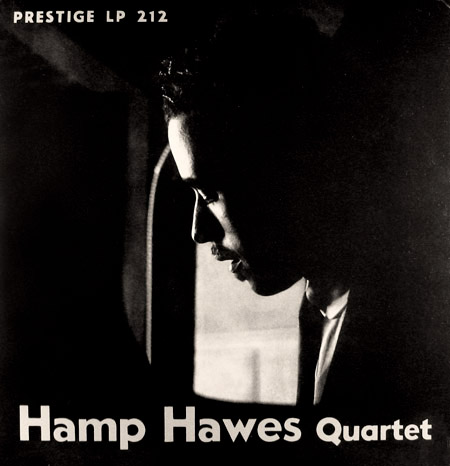They recorded eight songs, which were released on a 10-inch LP. None of the selections made it to either Spotify or YouTube, but I was able to find them and listen to them. This is almost certainly not one of Teddy Charles's sessions -- although there's no specific date on it, it is labeled as December 1952, and Charles didn't go out to the Coast until late January of '53. But it may well have been one of the things that made Bob Weinstock decide he needed a West Coast presence.
Thoughts on this session: (a) this is the third straight session we've had featuring vibes, and what are the odds of that? (b) with all the talk by John Lewis and Teddy Charles about how it's time to move away from the head-solos-head format, not everyone agrees, and thank goodness for that. This is the structure that modern jazz was built on, and it allows for great freedom, great improvisation, great listening.
This is Hampton Hawes's second recording for Prestige, and his first as a leader. He had played on the Wardell Gray/Art Farmer session that introduced "Farmer's Market," and he had opened my eyes on that one. I knew of Hampton Hawes, but had never sat down and listened to him closely. My loss. My gain now, and my delight. Hawes was a unique piano player. intense and playful, musically advanced, a solid swinger.
Here he's with Larry Bunker, equally well-known on drums and vibes. He had only come to the vibes fairly recently, but it hadn't taken him very long to master them. From a 1994 interview with Mal Sands:
It was 1950. I was 21 or 22 and I was playing drums with a trio that included the Hammond organ and the guitar. The organist, who was the leader, asked me if I’d ever played the vibraphone and I said, “No, I’ve never played one in my life.” He said, “Well, the fact that you know harmony and are an improvising player and know the keyboard and drums, it’s a natural for you. I’ve got an old set of vibes in my garage. Why don’t you take it home and work out a couple of tunes and we’ll see what happens.” Now I was aware of Lionel Hampton and just beginning to get into Milt Jackson. So I took the thing home, figured out how to put it together and spent three days just doing exercises and playing scales.
So I went on the job and did the first set on drums and then the guys asked: “What have you worked out?” I said that I had worked out a solo on a song and when he asked me what I wanted to play I said just play anything. So we played a couple of standard ballads and then some up-tempo things and got screaming applause from the audience. We came off the bandstand and there were people in the audience, musicians I had worked with who came up to me and said: “Geez, Larry, I didn’t know you played the vibes. How long have you been doing that?” I said: “Three days.”
Also interestingly, and unexpectedly for two West Coast musicians, both of them played with Bird. At 19, Hawes played an 8-month gig at the Hi-De-Ho Club in LA, for Howard McGhee's quintet with Charlie Parker. And Bunker? Well, let him tell it (from the same interview):
I did actually get to play once with Charlie Parker when I played a couple of tunes on piano at a dance job with him in L.A. at a place called the “Five-Four Ballroom. Some guys I knew where playing with them so I went down to catch the gig. There was a tune they wanted to play and the piano player didn’t know it. Larance Marable saw me and called me up to the stand and said: “You know that tune, don’t you?” I said: “Sure.” So I sat in and comped for Bird.Every tune from this session is a treat, with two virtuosos trading solos, running up each other's backs, never missing a beat or a cue or a challenge. It's hard to single out one, but what about "Move," the Denzil Best composition made famous by Miles Davis, John Lewis and Co. on the Birth of the Cool album. The Davis nonet, escaping from the strictures of bebop, plays it at about two and a half minutes. Hawes and Bunker, making it into their own speed-dialed bebop classic, play about the same number of notes and choruses, and bring it home in a minute and half.
Prestige put this out on a 10-inch, and later on a 7000-series 12 inch LP, the latter combined with a Freddie Redd session as Hampton Hawes/Freddie Redd -- Piano: East/West. How's that for an orgy of overused punctuation marks?



No comments:
Post a Comment